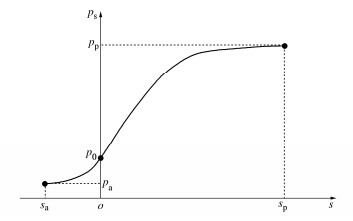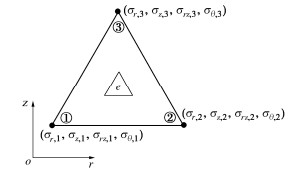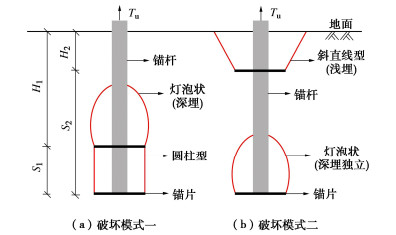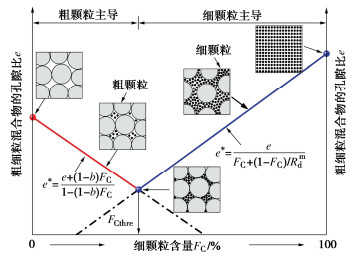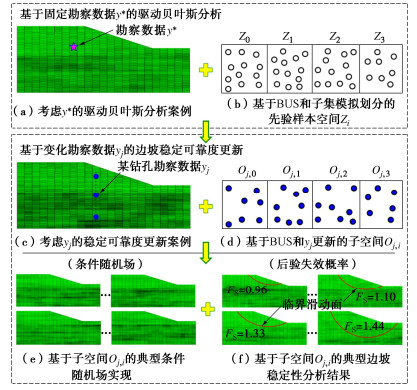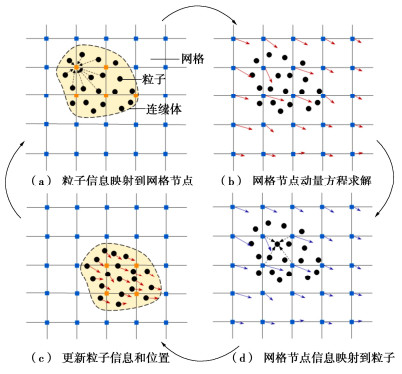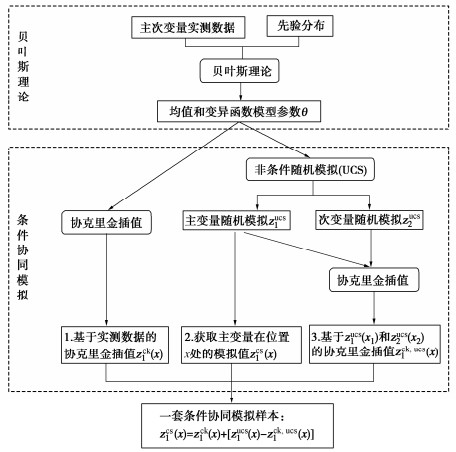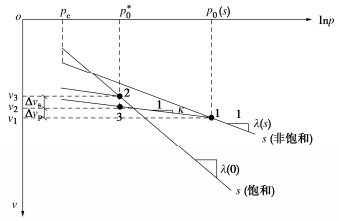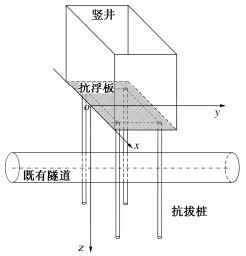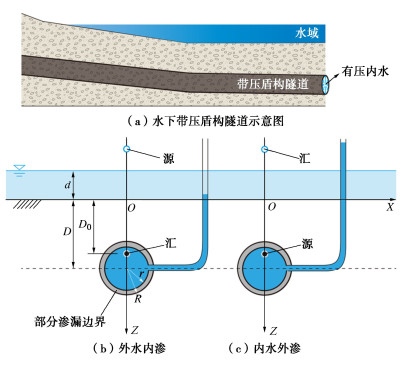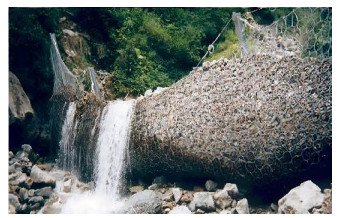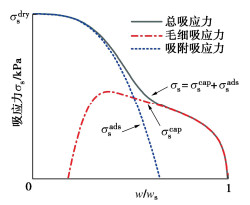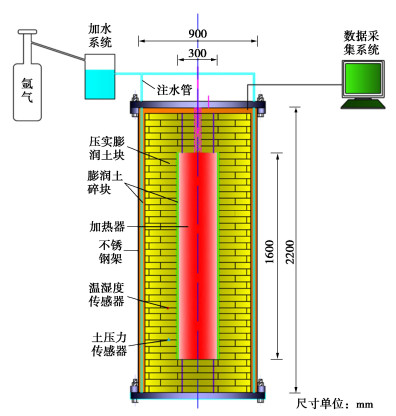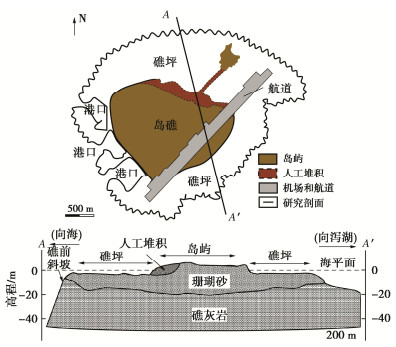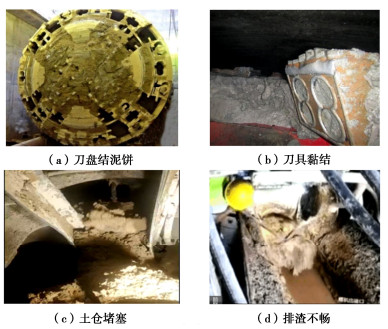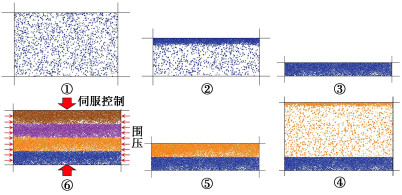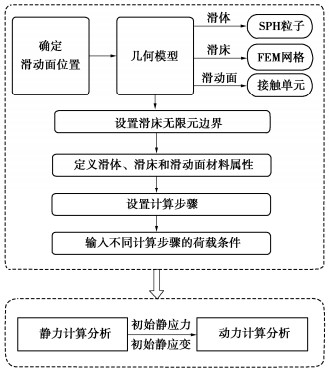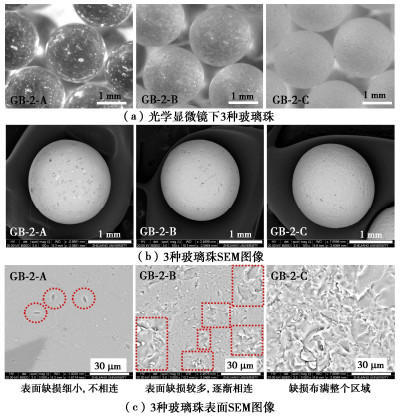2024 Vol. 46 No. 8
The determination of earth pressure is a key element for the design of retaining structures of deep excavations. However, the existing earth pressure models can not reasonably consider the change of soil properties induced by excavation activities. The piezocone penetration test (CPTU) is capable of effectively avoiding the sampling disturbance and quickly providing the continuous in-situ testing parameters of soils (cone resistance, sleeve friction, pore water pressure). Combining the CPTU tests and the displacement-based earth pressure model, the change of soil properties induced by excavations, surrounding buried structures (confined soil), soil arching effects, soil strength parameters and friction angle of the soil-structure interface are comprehensively taken into account to develop a unified earth pressure model (from active- to passive-state) under the Coulomb's earth pressure framework. The comparisons of earth pressures obtained between 1
With the advantages of low cost, short construction period and relatively small foundation disturbance, the bucket foundation has become one of the important foundation forms of offshore wind power in China. Because of its complex foundation structure, the classical method for foundations can not accurately evaluate the vertical bearing capacity of the bucket foundation. In this study, the lower bound method of finite element limit analysis is used to transform the bucket-soil interaction into an inequality constraint condition between the bucket-soil friction and the undrained shear strength of the soil, and a lower bound solution program for the vertical bearing capacity of the bucket foundation is established. On this basis, the effects of the non-uniformity of the soil strength, length-diameter ratio of the bucket foundation and friction between the outer wall of the bucket and the soil on the vertical bearing capacity of the bucket foundation are analyzed, and a formula for calculating the vertical bearing capacity of the bucket foundation considering the above factors is proposed.
At present, it is necessary to introduce the concepts of the critical burial depth ratio and critical spacing ratio artificially into the theoretical researches on the uplift bearing of screw anchors with multiple blades, which divides a continuous evolution problem into two special working conditions. However, the criteria of the two critical values are inconsistent, leading to risks in the engineering application of the theory. Based on model tests and combined with the digital photographic measurement technology, the studies on the uplift bearing characteristics of screw anchors in sandy soil foundation are made, and the main conclusions are drawn as follows: (1) The variation of the uplift load displacement curves of the screw anchors with single and double blades can be divided into two stages, growth interval and oscillation decline interval. The larger the burial depth ratio, the higher the peak load, but then the enhanced soil arching effects also lead to the more significant oscillation amplitude of the curve. (2) The curve of the breakout factor
The sand-silt mixtures, as common heterogeneous soils, are ubiquitous in nature and geotechnical engineering, and their particle contact state and mechanical properties are significantly affected by the factors such as density, stress level and fines content. In order to comprehensively describe the complex mechanical properties of the sand-silt mixtures within the fines content threshold (
Compared with the traditional backfill materials, the performance-controlled fluidized solidified (PCFS) backfill materials are characterized by high flow state and self-compaction, which can effectively avoid engineering problems caused by insufficient compaction, especially for backfill in narrow areas. Using silt as raw materials and cement as curing materials, the PCFS materials with controllable properties such as strength, fluidity and setting time are prepared. The influences of different initial conditions on the fluidity of the PCFS materials are discussed through the flow tests. In order to improve the flow performance of the PCFS materials, three water reducing agents, calcium lignosulfonate, naphthalene superplasticizer and polycarboxylate superplasticizer, are selected, and the effects of three water reducing agents on improving the flow of the PCFS materials are compared and analyzed. The results show that there is a positive linear correlation between the fluidity of the PCFS materials and the initial water content. The addition of cement will lead to a significant decrease in the fluidity of the PCFS materials, which mainly occurs when the cement content is less than 2%. The increasing range of fluidity of the PCFS materials by the three water-reducing agents is from large to small in the order of polycarboxylate superplasticizer > naphthalene superplasticizer > calcium lignosulfonate, wherein the incorporation of polycarboxylate superplasticizer and calcium lignosulfonate will introduce bubbles, and the "saturated content" of naphthalene superplasticizer and calcium lignosulfonate is 2% and 4%, respectively. Different cement contents will make the three kinds of water-reducing agent to improve the flow effects have a significant difference. The increase of cement content reduces the effects of the calcium lignosulfonate, has samll effects on the polycarboxylate superplasticizer, and shows " anomalous effects" on the naphthalene superplasticizer. Finally, the causes of "saturation content" and "anomalous effects" are discussed, and the expression formula for fluidity of the PCFS materials under the initial water content of 2
The Bayesian theory provides an effective tool to properly characterize the spatial variability of soil properties and quantify the effect of site investigation data (e.g., undrained shear strength data) on reliability of slope stability. However, the site investigation data sequentially appears at different spatial locations of a slope, and the model to characterize the spatially varying soil properties (e.g., random field model) usually involves a great number of uncertain parameters. These pose a great computational challenge for Bayesian updating of slope reliability considering spatially varying soil properties. A collaborative reliability updating approach for the slope stability with spatially varying soil properties considering different site investigation data is proposed. It first makes use of the Bayesian updating with structural reliability methods (BUS) to simulate random fields and perform slope stability analyses, and then employs the rejection sampling principle and collaborative analysis to characterize the spatially varying soil properties and update the reliability of slope stability considering different test data. As the site investigation data spatially appears within a slope, repeated simulations of conditional random fields and a significant number of slope stability analyses are avoided. Moreover, the combination of the BUS makes it possible for efficient slope reliability updating using the Bayesian analysis that involves high-dimensional model parameters. A single-layered soil slope with a non-stationary random field is employed to demonstrate the effectiveness and validity of the proposed approach. It is shown that the proposed approach provides an effective tool for dynamic characterization of spatial variability of soils and real-time reliability updating of slope stability under different site investigation data.
This study aims to propose a fragility analysis method for evaluating the longitudinal seismic performance of long-line utility tunnels based on nonlinear incremental dynamic analysis (IDA). To this end, a simplified beam-spring model is established, to reasonably consider the mechanical properties of the joint and the soil-tunnel interaction. A series of 17 sets of ground motion records are selected and uniformly scaled to different intensity levels as the input of one-dimension free filed analyses to obtain the ground motions at the bottom slab of a utility tunnel. Finally, the seismic analysis of the utility tunnel considering wave passage effects is conducted. Based on the IDA results, the optimal intensity measure is selected. With the damage measure of the peak joint opening, the fragility curves of the utility tunnel are established using the peak velocity at the bottom slab of the tunnel and the peak velocity at the ground surface as the intensity measures, respectively. The failure probability of the utility tunnel under different earthquake intensity levels is also obtained. The proposed fragility curves and failure probability of the utility tunnel in typical site Ⅱ can provide an effective tool to estimate the seismic performance of this type of underground structures and a reliable basis for predicting damage under different earthquake intensity levels.
The material point method (MPM) has good effects in simulating large deformation problems. However, the conventional MPM suffers from cell-crossing errors when particles cross grid boundaries, resulting in reduced accuracy. In order to overcome the cell-crossing errors of the conventional MPM, an improved convective particle domain interpolation material point method (CPDI) is proposed based on the conventional CPDI framework and the adaptive orthogonal improved interpolation moving least squares method (AOIIMLS). By constructing weighted orthogonal basis functions and disregarding the minimal or zero elements in the new diagonal matrix, the inverse matrix computation is avoided, and the robustness is enhanced. In the improved CPDI method, the particle domain velocity field is calculated using the velocity gradients, and the AOIIMLS shape functions are employed to reconstruct the background grid velocity function using the particle velocity and particle domain corner point velocity. The accuracy and applicability of the improved CPDI method are verified through simulations of various scenarios such as the compaction of a one-dimensional column under self-weight, the collapse of a sand column and the centrifuge tests on tunnel collapse. The results show that the improved CPDI method reduces the cell-crossing errors caused by the particles cross grid boundaries and achieves higher accuracy. Finally, the improved CPDI method is employed to simulate the whole process of ground collapse in the Jinggang Road Station–Shazikou Station tunnel section of Qingdao Metro Line 4, effectively confirming the applicability and advantages of the method in addressing large deformation problems in geotechnical engineering.
The spatial variability characterization of soil properties in offshore wind farms is essential for offshore engineering. The multi-source data fusion can reduce the uncertainty of characterization. However, the existing methods cannot simulate geotechnical properties based on the non-co-located multi-source data, and do not consider the effects of statistical uncertainty. To overcome these challenges, a conditional co-simulation method based on the Bayesian theory is proposed. The Bayesian theory is first used to estimate the cross-variogram model based on the non-co-located multi-source data. Then, the conditional co-simulation is used to generate realizations of spatially varied soil properties, which can characterize the spatial variability with consideration of statistical uncertainty. The proposed method is applied to an offshore wind farm to establish the spatial variability model for the unconfined compression strength (
The miniature earth pressure transducer is one of the key testing tools in geotechnical centrifuge modeling. Aiming at solving the classical problems such as arching effects, size effects and thickness-diameter ratio in the measurement of rigid transducers, and improving the frequency response rate and induction accuracy, a soft-contact pressure transducer ESP-Ⅱ is developed, and its innovations and design methods are introduced. Taking two internationally representative earth pressure transducers as reference, a series of centrifugal model tests are designed and carried out to evaluate its accuracy, frequency response and applicability. The main conclusions are as follows: (1) In the static centrifugal acceleration tests spinning up from 5
The BBM model for unsaturated soils is analyzed, studied and validated. A modification is further made to the BBM model, so that the model is more consistent with the variation of matric suction in unsaturated loess. The iterative calculation method for the BBM model in the literature is performed under the stress path of
The heave of the existing shield tunnels will be induced due to the above excavation, and then structural damages, including leakage and cracking, easily happen. The combination of the shaft excavation and anti-uplift portal frame is an effective technique to limit the heave of the existing tunnels, while the theoretical method is absent presently for the design of the anti-portal frame. Thus, the analytical solutions for the performance of the existing tunnels are proposed for both the longitudinal and cross-section deformations of the existing tunnels during the shaft excavation and foundation pit excavation, respectively. The flow chart is also provided. The results predicted by the analytical solutions are in good agreement with those of the field measurement and 3D numerical simulation, which proves the reliability of the analytical solutions. The mechanism of the anti-uplift portal frame is carefully investigated, and the sensitivity analysis of the buried depth of the existing tunnels and the excavation size of the shaft is performed. The results show that the anti-uplift portal frame can effectively control the deformation of the existing tunnels caused by the above excavation, strongly depending on the thickness of the soil above the existing tunnels. The efficiency of the anti-uplift portal frame is stronger with the decrease of the thickness of the soil above the existing tunnels. The effects of the anti-uplift portal frame mainly depends on the force between the anti-floating slab and the soil, and the uplift pile shows a minor influence on the deformation of the existing tunnels.
Focusing on the variation of relaxed water and earth pressures of shallowly shield tunnels under external water infiltration and internal water exosmosis conditions, the seepage field and hydraulic gradient considering internal water pressure are firstly, derived based on the modified image method. Then, the solutions for the water and earth pressures in arbitrary locations within the relaxed zone are obtained based on the modified Terzaghi's formula considering the horizontal distribution of stress. The effectiveness of the computational model is verified by comparing with the numerical results. It is shown that the principal stress path in either an arc or a parabola form can effectively capture the stress distribution within the relaxed zone over the tunnel crown. When the ratio of permeability of strata to that of linings is below 1000, the internal water pressure head has significant effects on the water and earth pressures. The increase of internal water pressure head will cause the reduction on the effective stress in the relaxed zone, which induces the unloading of soils. Moreover, it will also result in the increase of the total pressures at the tunnel crown of the relaxed zone, implying that the growth in pore pressure dominates the variation of the water and earth pressures. The linear regression of five-parameter orthogonal analysis suggests that the buried depth and tunnel radius have significant positive impacts on the earth pressures, while the influences of friction angle and cohesion are negative. Under the scenarios of relatively low-permeable strata, the influences of internal water head on the total and effective earth pressures at the tunnel crown are significantly negative and positive, respectively.
To solve the dynamic effects of blocking and permeating water under the scouring effects of mudflow on flexible protection projects, a coupled S-ALE-FEM method considering the water blocking and permeability effects of mudflow flexible protection process is established. The equivalent thin film unit of the ring network considering the water-blocking-permeability effects is established according to the Euler-Lagrange coupling algorithm based on S-ALE and Ergun formula to realize the equivalent water-blocking-permeability quantification calculation of the dense curved beam-like metal ring network mudslide protection process. The kinetic analysis of the whole process of mudflow flexible protection is carried out in conjunction with the USGS mudflow flexible protection model tests, and the results are compared with the test ones. The study shows that the proposed coupled method can reproduce the full process inversion of debris flow impact, height climbing and infiltration accumulation. Compared with those of the tests, the maximum errors of debris flow accumulation height and accumulation width are 11.9% and 10.3%, respectively, and the maximum difference of debris flow slurry passage is 3.2%. For comparison between the tests and the dynamic response of key components of the flexible protection system, the maximum time-history errors of right side anchor rope, left side anchor rope and mesh are 3.2%, 16.4% and 14.4% respectively. Compared with those of the two theoretical algorithms not considering the water blocking effects, the accuracy of the calculated results of the peak debris flow impact force and the difference of debris flow slurry passage are improved by 4.69% and 17.50%, respectively. The S-A-F coupling method can solve the design and calculation challenges of mudflow flexible protection projects.
The interaction between clay particles during the process of desiccation cracking is highly complex, making it challenging to conduct quantitative researches on the formation mechanism of cracks at the particle level. The capillarity and adsorption in clay is distinguished based on the suction stress characteristic curve (SSCC) in unsaturated soils. A contact model of discrete element method (DEM) that accounts for the change of attraction between clay particles with water content is then established, and the numerical simulation of desiccation cracking in clay is carried out. The simulated results are compared with those of laboratory tests, and the findings indicate that the crack morphology, crack development history and strain of the soil sample obtained by the DEM simulation are in good agreement with the laboratory results, verifying the reliability of the DEM model. Further analysis of the simulated results reveals that: (1) The capillarity and adsorption both play a role in the desiccation cracking process of clay. With the decrease of water content, the effects of adsorption gradually exceed those of capillarity. At the dominant stage of adsorption, the average displacement of simulated soil particles along the crack distribution direction accounts for 73% of its final value. (2) The total contact number between soil particles initially decreases and then increases as water content decreases. (3) The physical contact force between soil particles will increase rapidly at the dominant stage of capillarity/adsorption, resulting in stress concentration, and the contact between soil particles will be centralized and cracks will be formed. The proposed DEM contact model is of significant physical implications and can offer valuable insights into the underlying mechanisms of desiccation cracking in clay at the particle level.
The buffer material plays a crucial role in the long-term safety of a high-level radioactive waste repository as it serves as a defense between the waste container and the host rock. To investigate the long-term performance of Gaomiaozi (GMZ) bentonite under repository conditions, based on the China-Mock-up test at engineering scale, the finite element code LAGAMINE is established to establish the THM numerical model. The complex boundary conditions and material properties involved in the test are considered, and the simulated results of temperature, relative humidity and swelling pressure are compared with the experimental ones over the past five years. The temperature in the China-Mock-up test is found to be periodic and linear, primarily influenced by the room temperature, which is accurately captured by the proposed model. Furthermore, the overall variation of the relative humidity at different locations is well reproduced. A desaturation-saturation process is observed in proximity to the heater, while it does not occur far from the heater. Additionally, the simulated results exhibit good agreement with the recorded data, effectively reflecting the increasing trend of stress over time. Besides, the interaction between temperature, humidity and stress of bentonite under the coupled THM conditions is achieved. These findings provide valuable insights into the long-term behavior of buffer materials in a repository environment and serve as an important reference for further understanding.
The seismic response analysis of the coral islands in South China Sea is of practical significance for the seismic safety of the islands. A two-dimensional FEM model is established for a typical coral island in Xisha Islands considering the unsaturated zone caused by the fluctuation of daily tides. The accuracy of the model is then verified based on the seismic event records captured by the seismometers installed on the coral island. Then the nonlinear seismic response of the coral island with different earthquake signal inputs is explored. The major conclusions are drawn as follows: (1) The PGA amplification is more significant at the edge of the island because of the bowl-shaped interface between the coral sands and reef limestone, decreases from the surface of the island (loose coral sand layer) with depth and bends at the lithological and the unsaturated-saturated interfaces. (2) The resonance periods of the acceleration response spectra coincide with those of the input ground motion. However, the surface ground motion durations are significantly enlarged as compared to those of bedrock. (3) The saturation degree impacts the PGA amplification factor and the Arias intensity, but has less effects on the PSA. The findings provide significant guide to the seismic stability evaluation and seismic design of the coral sand sites in Xisha Islands.
The mechanical construction is widely used in geotechnical engineering, but clay clogging is the major problem that hinders construction. Shield, drilling pile machine and other equipments are prone to mud cake, clogging, poor soil discharge and other phenomena during the construction in clay stratum, which leads to the increased torque of the apparatus, intensified tool wear and reduced construction efficiency. The clay clogging generally occurs at the interface between clay and metal surfaces, and reducing the adhesion force of the clay to the metal surfaces is the key to solving the above issues. A method of using the electro-osmosis technology is introduced to form a water film between the clay and the metal interfaces to reduce the clay adhesion. The tilted-plate tests and electro-osmosis tests are conducted on four types of clay under different voltages and water contents. The experimental results show that the electrodynamic behavior of the clay is influenced by the water content and clay minerals, and needs to meet a certain voltage threshold. The critical sliding voltage threshold of the four clay samples in the experiment is concentrated at 4 V, with slight differences influenced by the water content. After the voltage exceeds the threshold, the detachment time of the soil samples decreases sharply. Increasing the voltage from 9 V to 11 V does not show a significant difference in the detachment time. After the voltage exceeds 7 V, increasing the voltage has few effects on reducing the stickiness of the soil samples, but the energy consumption during the electro-osmosis process increases significantly. When applying the electro-osmosis method in practical engineering, the factors such as energy consumption and formation conditions should be considered comprehensively so as to select the optimal voltage-based electro-osmosis viscosity reduction program and improve the construction efficiency.
The non-continuous retaining structures such as anti-slide piles rely on the soil arching effects to provide support safely and economically in slope engineering. Considering the significant differences in the mechanical properties of sands, to reveal the mechanism and evolution patterns of horizontal soil arching between piles in sand slopes, the discrete element method (DEM) is used to simulate the formation process of horizontal soil arching. On the basis of the traditional force chain analysis, it is proposed to study the formation process of soil arching by screening high stress particles. Furthermore, the analysis of the soil arching effects under different conditions from a microscopic point of view is conducted to reveal the evolution process of "stress arching" and "displacement arching". The results demonstrate that the dynamic evolution of horizontal arching in both dense and loose sands can be divided into three evolutionary stages, corresponding to the shear behaviors of the two sands, i.e., strain softening and strain hardening phenomena, which reveals the evolution patterns of the soil arching effects in the sand slopes. Additionally, the influences of macro-micro DEM simulation parameters on the arching process and performance are discussed. The results indicate that the arching span has the greatest impact on the load transfer efficiency.
Based on the SPH-FEM coupling method, a frictional velocity weakening model for sliding surface is introduced and a numerical simulation method which can simulate the whole failure process of the landslides triggered by earthquake is proposed. The Tangjiashan landslide is simulated by the proposed method, and the simulated results are consistent with the on-site investigations and the laboratory test results. Based on the calculated frictional strength on the sliding surface, the whole failure process of the Tangjiashan landslide is divided into four stages: the triggering stage, the frictional weakening stage, the low frictional stage and the gradually stabilizing stage. The simulated results indicate that the high-speed movement of the sliding body is triggered by the interaction of the increase of the velocity and the decrease of the frictional strength. The parameter
It is known that the soils surrounding a foundation pit are commonly in an unsaturated condition and the displacement of a retaining wall routinely rotates around wall bottom (i.e., RB displacement mode). The bearing capacity of strip foundations at wall bottom with a single-sided sliding surface and the vertical anti-sliding force of wall-soil system under RB displacement mode with an overall down-sliding are first derived in the framework of the two-stress state variable theory for unsaturated soils. For uniform and linear suction profiles, the limit equilibrium method is then adopted to provide a solving process on the safety factor against basal heave of foundation pits in unsaturated soils, respectively. Finally, based on the verifications of the theoretical solutions reported in the literatures with an engineering case of foundation pits, the influences of different wall displacement modes are explored. The results show that the proposed safety factor against basal heave of foundation pits accounts for unsaturated characteristics of soils and RB displacement mode of a retaining wall. The proposed safety factor compares reasonably well with the available theoretical solutions of both the foundation bearing capacity model and the limit upper bound approach, and it can be naturally degraded to that of saturated soils. The vertical anti-sliding force and the safety factor against basal heave of foundation pits under RB displacement mode of retaining walls are smaller than those under an in-situ state. The safety factor against basal heave of foundation pits is conservative for simplified calculation of unsaturated soils taken as saturated soils ignoring unsaturated strength characteristics.
There are limitations from the pavement structure layer and construction site space during the deep soft soil reinforcement of the existing sand-filled subgrade in expansion of expressways. Firstly, a new method using the squeezed branch pile (SBP) with one single plate for treatment of the existing soft foundation is proposed. In this method, a plate is set on the top of the piler to achieve the effects similar to a pile cap or support plate without breaking the road structure layer. Secondly, a physical model test on the pile group foundation is performed, and a pile-soil unit is simulated to study the bearing behavior of the SBP. By analyzing the mechanical and deformation indices of the pile, plate and soil, the bearing performance and soil-deformation characteristics of the new reinforcement method are studied. Finally, a simplified two-dimensional model for the reinforcement method with SBPs for the existing sand-filled embankment is derived by considering the soil parameters and pile sizes. The results indicate that the axial force of piles and soil pressure vary with time under constant loads due to the compressibility of soft soil and the properties of loose sand. The total axial force at the top of the pile is approximately positively correlated with the magnitude of the constant loads linearly. At the same time, the larger the diameter of the support plate, the greater the total axial force at the top of the pile and the higher the proportion of pile-bearing loads. It is found that the pile-bearing ratio of the reinforcement method with SBPs is about 70%. In addition, the proposed two-dimensional simplified model for parameter analysis shows that the minimum pile spacing in the sand-filled subgrade is related to the overlying load, internal friction angle of sand-filled soil, strength index of deep soft soil and geometric parameters of support piles.
A vacuum consolidation model equipment is designed for performing a series of vacuum consolidation tests on two dredged clays with different liquid limits reconstituted at different initial water contents. The experimental results indicate that the ratio of the initial water content to the liquid limit is a useful dimensionless index for describing the behaviour of fine particle migration of dredged clays under vacuum pressure. It is found that there is a unique critical value of the ratio of the initial water content to the liquid limit for the occurrence of particle migration. When the ratio of the initial water content to the liquid limit is less than the critical value, the particle migration of dredged clays does not occur under vacuum pressure. But in the case that the ratio of the initial water content to the liquid limit is larger than the critical value, the particles of dredged clays migrate to the drainage surface, resulting in the enrichment of clay particles in the vicinity of the drainages. The level of clay particles enrichment increases with the increase in the ratio of the initial water content to the liquid limit.
The small-strain shear modulus and damping ratio are the important dynamic properties of granular soils, which are influenced by the packing density and stress states of the soil element as well as the particle characteristics including gradation, shape of particles, etc. As one of the important particle characteristics, however, the surface roughness of particles is often ignored by the previous investigations regarding the small-strain dynamic properties of granular soils. In this study, the small-strain dynamic properties of specimens of glass beads with different surface roughnesses are measured using the energy injecting virtual mass resonant column system. The surface roughness of the glass beads is quantified with the assistance of the three-dimensional interference microscope. The experimental results show that the small-strain shear modulus decreases with the increasing surface roughness of particles, while there is no obvious effects of surface roughness on the small-strain damping ratio. Clearly, the effects of surface roughness on the small-strain dynamic properties cannot be ignored particularly when other influencing factors, such as particle shape and gradation, are similar.


